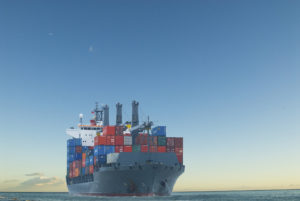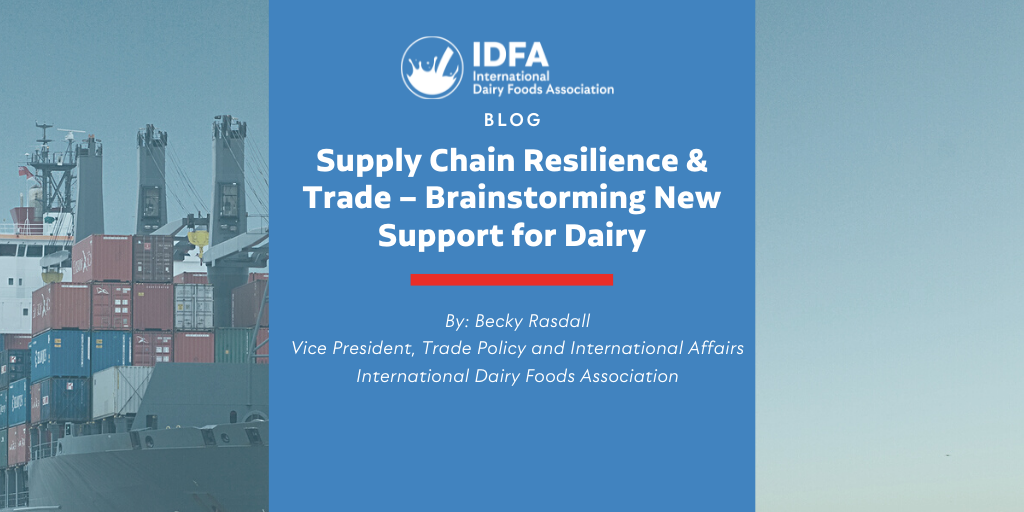
The past year has made U.S. dairy exporters and importers painfully aware of the global agricultural supply chain’s shortcomings and has resulted in their asking the Administration and Members of Congress for help in fixing it. The list of IDFA’s members’ pain points in trying to import their ingredients and export their products is both significant and impressive: whether having product sit on rail sidings in the Midwest for weeks on end before it can even get to a port, trying to arrange an importing vessel to be offloaded in a mere 24 hours after waiting for weeks for an offloading appointment, or having to haggle and hope to get outbound vessel space, the supply chain supporting dairy trade is clearly not working.
On top of port congestion and shipping delays, IDFA members face non-tariff policies from the European Commission which will imperil not just the U.S., but also the global dairy supply chain. The European Commission is in the process of implementing new health certificate requirements that will entirely cut off U.S. dairy exports to Europe, yet few have been able to fully piece together the ripple effect such a move might have on global dairy trade. Not only is the U.S. sole supplier of unique ingredients used in European production of specialized nutrition products sold worldwide, but U.S. exports to New Zealand and other countries near Europe would also suffer as Europe requires certificates at all layers of the supply chain – ingredients in processed goods, transshipments, etc.
The question for everyone involved is what should we do about it? As a starting point, IDFA believes there is significant need for supply chain transparency and more education for our government colleagues. Congressional offices and federal agencies often do not see beyond issuance of an export certificate or issuance of import approvals. Weeks waiting for terminal appointments, outbound vessels, or rail carriers are commercial transactions that are rightly outside their immediate areas of focus. Enter IDFA, to ensure lawmakers and policymakers alike have details about how U.S. dairy products are made, shipped, and reach their final destination, and what problems our members are encountering along the way:
IDFA has been working to shed light on the global implications of the European certificate by helping U.S. officials, global suppliers, packaging producers, and processors understand that they will encounter supply shortages unless the European Commission changes its regulation and implementation timeline. At a time when global public health must be a collective priority, opaque supply chains combined with protectionist regulatory actions have created a looming crisis in global supply chains for specialized nutritional products for some of the world’s most vulnerable populations, including infants and medically-supported adults.
Clearly the dairy supply chain was originally built around a different trade environment, limited levels of exports, protecting competitive business information, and without any notion that there could one day be a total breakdown of the kind U.S. dairy traders are currently experiencing. It is also clear that something must change for the supply chains supporting U.S. dairy trade. Transparency and education are a good start, but they don’t fix the actual trading problems facing IDFA’s members. Such complex problems require brainstorming, fresh perspective, and bold willingness to think outside the box – something IDFA thinks it is past time to do for U.S. dairy supply chains.
This week, IDFA submitted comments in response to the U.S. Department of Agriculture’s request for input on supply chain resiliency. Although USDA’s notice cast a broad net for how to make all agricultural supply chains more resilient through historic programs like pandemic payments, IDFA’s comments encouraged USDA to take a more holistic approach to supply chain resilience in the context of trade. As outlined in the comments, federal agencies supporting robust agricultural supply chains should consider a diverse suite of solutions when thinking about how better to service U.S. traders, potentially including:
- Development of a trade advisory committee supporting supply chains, to obtain input from cleared advisors on supply chain issues which may otherwise not be visible to federal officials and make recommendations on possible solutions;
- Direction to the Office of the U.S. Trade Representative to immediately engage in the matters, both domestically and abroad, within the supply chain that are impacting U.S. agricultural exporters, with a view towards developing improved and enhanced trade facilitation text commitments in the future; and
- Consideration of new data points and data collection tools to increase supply chain visibility and market transparency, such as whether sufficient HS codes exist, the ability to track transshipments of U.S. goods through foreign ports, information on number of detentions, time delays in shipments, and other basic transparency of imports and exports that might facilitate the identification of problem areas within the supply chains.
Whether or not these ideas are the right ideas or will be taken up by the Administration remains to be seen. But for now, IDFA is pleased to be leading the brainstorming, outside-the-box discussion on possible new supports for U.S. dairy trade supply chains and welcomes your views.
Have input? Reach out to IDFA’s vice president for trade policy and international affairs, Becky Rasdall, to join the conversation.

Becky Rasdall Vargas
Senior Vice President, Trade and Workforce Policy



